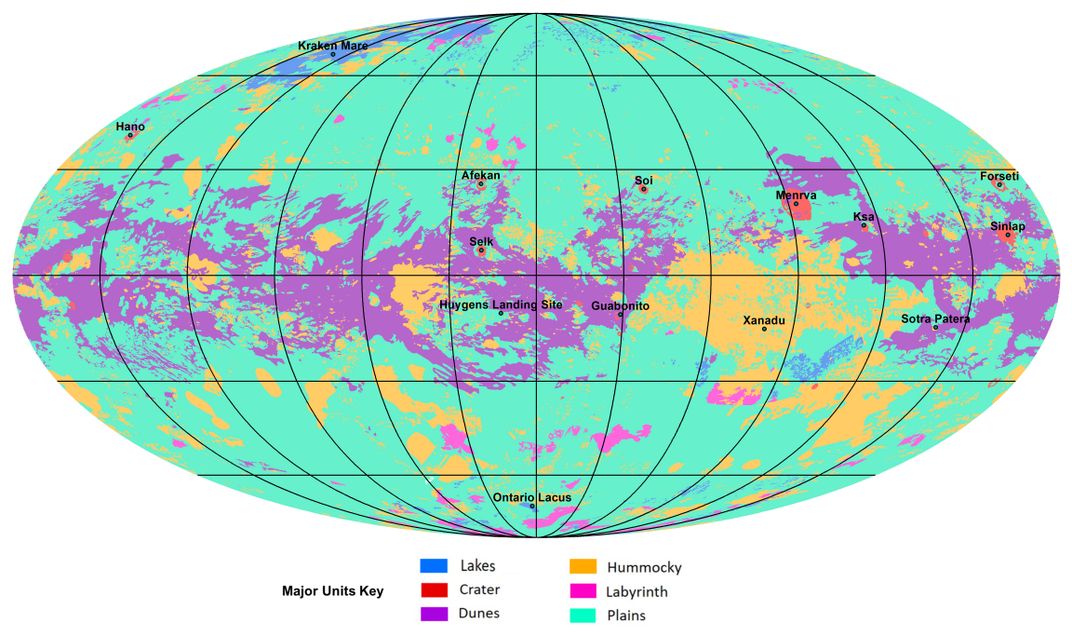First Global Map of Saturn’s Moon Titan Reveals Secrets of Earth’s ‘Deranged’ Twin
The map showcases the planet’s flat plains, sand dunes, hilly terrain and lakes full of liquid methane
/https://tf-cmsv2-smithsonianmag-media.s3.amazonaws.com/filer/a5/31/a53107b4-6e4a-4aea-80c7-4720582e5b75/titan_multi.jpg)
Researchers recently released the first complete map of the surface of Saturn’s strange moon, Titan. The new map of the moon should be a big help in planning the Dragonfly mission, which will send a specialized spacecraft to Titan in 2026.
While the map is new, the data used to make it has been around a few years. NASA’s Cassini spacecraft spent 13 years exploring Saturn and its moons before the probe plummeted past Saturn’s rings and burned up in the planet's atmosphere in 2017. Over its decade of service, the spacecraft swung past Titan over 120 times, surveying the terrain of the 1,600-mile radius moon with a radar instrument that penetrated its thick shroud of nitrogen and methane, reports Jonathan O’Callaghan at Nature. For the new map, astronomers combined that data with other readings from the craft’s infrared and visible light instruments. The result appears in the journal Nature Astronomy.
Scientists already knew how weird Titan is; it’s not called a “deranged version of Earth” for nothing. And the new map is showing off the moon’s oddities in detail.
About two-thirds of Titan, which is roughly the same size as the planet Mercury, is covered in flat planes, mostly near its equator. Sand dunes cover about 17 percent of the surface while about 14 percent is “hummocky,” a classification denoting hilly or mountainous terrain. Labrynthine valleys sliced into the landscape by rain and erosion cover about 1.5 percent. Lakes of liquid methane also cover about 1.5 percent of the moon, most of which are at the moon’s north pole. As Titan orbits Saturn, Saturn's elliptical orbit around the sun probably leads to a longer summers in Titan's north, which allows more rain to fall than in the south.

While methane lakes are unique to Titan, other geological processes should be fairly familiar to earthlings, says study co-author David Williams of Arizona State University.
“The Cassini mission revealed that Titan is a geologically active world, where hydrocarbons like methane and ethane take the role that water has on Earth," he says in a press release. “These hydrocarbons rain down on the surface, flow in streams and rivers, accumulate in lakes and seas, and evaporate into the atmosphere. It’s quite an astounding world!”
Tracy Gregg, planetary geologist at the University at Buffalo who was not involved in the study, says this kind of detailed geologic mapping is the first step to answering more questions more about the formation of Titan and how other processes on the planet work. “One [question] is: what kinds of changes has Titan gone through that are seasonal, and what sort of changes might be driven by the internal [heat] of Titan?” she tells O’Callghan.
Rosaly Lopes, lead author and planetary scientist at NASA’s Jet Propulsion Laboratory, agrees. “Now that we have this global picture, we need to start to correlate these units with climate models to find out how the rain and wind are behaving, how the landscape is evolving,” she tells Leah Crane at New Scientist.
Because the moon’s geology and atmosphere are so similar to Earth, Titan is one of the prime candidates for finding life in our solar system, Lopes says. Even so, Titan’s frigid temperatures—it averages -300 degrees—means the biochemical reactions needed to produce life are likely not taking place across most of the moon. But a study published in the journal Astrobiology last year suggested that the conditions needed for life might exist in Titan’s craters and cryovolcanoes. Luckily, there’s now a map to help our space probes seek it out.